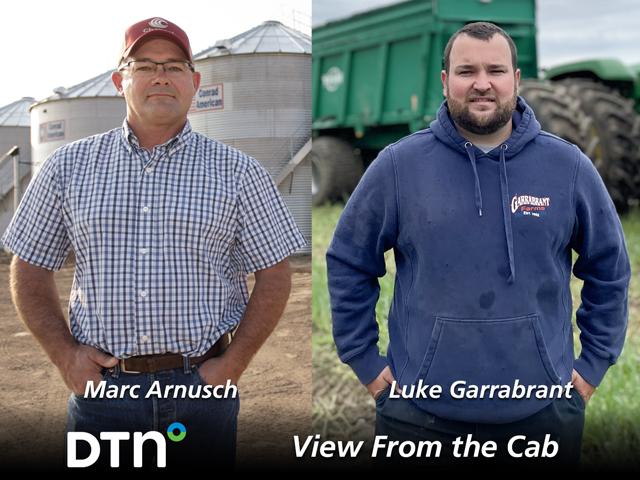Smith's Favorite Story of 2022
When Farmers Voice Views and Attitudes
Editor's Note:
The turn to winter traditionally has us thinking back over the year that was. Here in the DTN/Progressive Farmer newsroom, we're also prone to look back on the accomplishments, the challenges, and the things that didn't turn out as planned. In that vein, we again asked our reporters and editors to look back at some of their favorite stories from 2022. The pieces range from hard-hitting investigative journalism, to heart-tugging stories of loss, to the fun discoveries that can be found on farmsteads and small towns. We hope you enjoy our writers' favorites, with today's story by Pamela Smith.
**
DECATUR, Illinois (DTN) -- It takes courage to bare your soul in print. And that's what I ask two farmers to do each week throughout the growing season in a feature DTN calls View From the Cab.
Farmer readers often say they wish more was written about everyday farm life and the challenges agriculture faces. This series does that. It talks about what farmers think, how they make decisions and what they do each day in their own voice. And that is why it is an easy pick as my favorite editorial project.
This year Colorado farmer Marc Arnusch and Ohio farmer Luke Garrabrant volunteered to tell their stories and we produced 29 segments from May through November. It was the 16th year for View From the Cab and no one could say 2022 was boring given the uncertainty of inputs, soaring commodity prices and world-wide unrest.
Much like the proverbial potato chip predicament ... I can't seem to pick just one of those articles as a favorite, but some highlights stand out.
P[L1] D[0x0] M[300x250] OOP[F] ADUNIT[] T[]
The features documented the changing crop season in two very different parts of the country and through significantly different weather scenarios.
In the arid West, Arnusch battled a drought so dire that he was forced to idle some winter wheat acres to make the most of limited irrigation water on the acres that remained. By contrast, Garrabrant fought spring rains and finally planted corn and soybeans later than he would have liked. That backed him up on spraying and wheat harvest and hay baling -- most everything got done, but the summer felt like a hurry-and-wait marathon for the young farmer.
Arnusch couldn't buy a rain. Garrabrant mostly got moisture every time things began to dry out.
The contrast between the two farmers regarding career stage is remarkable too. Arnusch, at 49, has a son working in the business and he is helping another young couple get established in farming. Find Arnusch's profile article here: https://www.dtnpf.com/….
Garrabrant, at 26, worked with his father growing up and after college, but decided to strike out on his own as an independent farmer. Find Garrabrant's profile here: https://www.dtnpf.com/….
What continued to amaze me throughout the effort, though, was how much common ground the two farmers shared, especially since they've never met. Arnusch exercised his independent will to farm early in his career, too. But a common thread throughout the series was how much farming fathers have shaped and continue to influence their lives and careers. Read more about their views on fatherhood here: https://www.dtnpf.com/….
Other similarities cropped up over the summer. Both farmers have wives woven into the fabric of their farming operations. Both are facing competition for land and resources from urban encroachment and energy projects, such as solar and wind. They talk about this challenge of weighing those green energy opportunities in this article: https://www.dtnpf.com/….
Mid-summer, both farmers made strategic decisions to pivot away from businesses that had become unsustainable. For Arnusch, it was a difficult choice to discontinue selling seed wheat to focus on more profitable sales of seed barley. For Garrabrant, shortage of labor availability caused him to exit wheat and hay businesses so he could expand and concentrate on corn and soybean acres. Read more about those decisions here: https://www.dtnpf.com/….
They discussed the escalating move toward biologicals and how they view carbon credits: https://www.dtnpf.com/…. The farmers traded and upgraded machinery: https://www.dtnpf.com/…. There was a discussion on downtime and balancing of farm and family obligations: https://www.dtnpf.com/….
And, the farmers weren't afraid to have a little fun as we churned up local customs, sayings and attitudes toward grain carts and auger-in or out: https://www.dtnpf.com/….
For a writer, the chance to spend this much time talking to sources is a treat. For the farmers involved, they get only so many chances in their career to put in a crop. Now they have a record of what happened to refer to and reflect upon. And there's a network of new connections from interacting with readers of the column. Arnusch even got a note from his high-school English teacher.
The year wrapped up at: https://www.dtnpf.com/…, but these farmers remain valued sources as we cover agronomy and agriculture.
Interested in becoming a View From the Cab contributor? We're fielding applications. Send an email describing your farm and why you'd like to help others see agriculture through the eyes of a farmer.
Pamela Smith can be reached at pamela.smith@dtn.com
Follow her on Twitter @PamSmithDTN
(c) Copyright 2023 DTN, LLC. All rights reserved.




